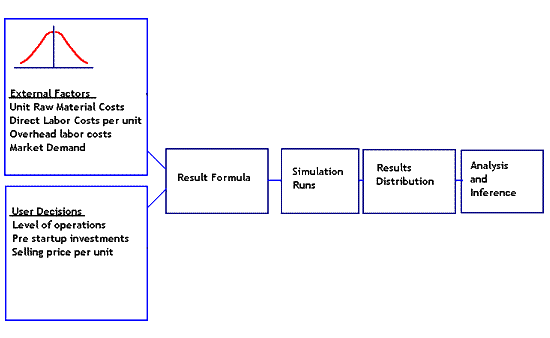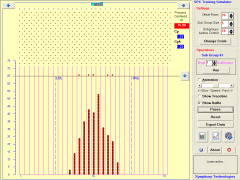Definition of Simulation:
Simulation means mimicking of real life or potential situations, usually using computers. It is the imitative representation of the functioning of one system or process by means of the functioning of another, such as a computer simulation of an industrial process. With simulation, one can examine a problem that is often not subject to direct experimentation.
Use of Simulation:
Simulation has been one of prime methods used as a decision support tool in industry. It is a powerful tool for designing and analyzing complex and dynamic systems to predict their behavior under different conditions on a time scale. Simulation is a highly cost-effective method of testing new processes without having to carry out actual experiments. This can save enormous amounts of money, which would otherwise be spent on pilot programs, yet can produce better results much faster.
Simulation should be used when it is expensive and/or dangerous to run the real systems. With simulation, one can
- Gain better understanding of working of a system
- Identify problems prior to implementation
- Test the potential effects of changes
- Identify areas for resource deployment
- Design efficient and cost-effective systems
Basic Steps of a simulation project:
Les Oakshott, in his book 'Business Modeling and Simulation' describes detailed stages of a simulation project.
The basic steps involved are:
- Define the process / problem
- Collect Data on various events occurring in the process.
- Build Computer models
- Which mimic independent events occurring in the process, the way they would occur in real processes. The computer model uses the observed probability distribution function of each event to do so.
- Which give the user the flexibility to control events and parameters of the process the way he desires.
- Run the simulation models through several recursions with a combination of real life variability generated by the computer, and controllable factors set by the user.
- Observe the results and their variation and document them.
- Make inferences and decisions based on the results of simulation.
An important step is creating a Model that is closely corresponds to reality. It is a logical description of how a real life system works, with all its inputs, outputs and interactions defined. Starting with a basic model one can go on gradually refining it as the understanding of the system improves. For more complex problems, the user can run the mimic of a real life process using the computer to generate uncontrollable events occurring naturally in the process and taking user input on the controllable events that are settable.
Let us take an example where we want to run a Risk Analysis on an investment proposal.
The parameters that the user has to decide upon are
- Level of operations in terms of number of units to be produced.
- Pre start-up investments to be incurred
- Selling price per unit
Some of the parameters that are not decided by the user, and are actually the function of external market conditions are
- Unit Raw Material Costs
- Direct Labor Costs per unit
- Overhead labor costs incurred to run the operations
- Market Demand
These external parameters are not deterministic. The value of each of these parameters cannot be predicted with certainty. Prediction is done by collecting historic data, studying the market conditions and expressing the value as the likely range in which it can occur. The likelihood of each of the values in the range occurring is expressed by a probability distribution function.
A model is created by defining:
- The values of controllable factors as decided and planned by the user.
- The values of external factors expressed as probability distribution functions.
- The formulae for profit computation considering all the factors.
The model is then run through a large number of recursions. (Usually 500 to 1000 runs, depending upon the complexity of the model). For each run, the computer generates and assigns values to each of the external variables. These values are based on the probability distribution function of the individual variable.
The outcome of each of the runs is a single value of profit (or loss). As a result of recursive runs of the model, many values of profit are generated. These are organized in form of their own probability distribution.
The probability distribution of the results helps us in determining the chances of making profits, and thus evaluating the risk (of making losses) involved in the investment proposal. This model is diagrammatically represented as below.

Applications of Simulation:
Simulation is widely applied to variety of applications. Since simulations mimic reality, they help to a great extent in making decisions under uncertainty. The success of a simulation depends on how closely the model represents reality.
Some of the commonly used applications of Simulation are described briefly below:
Inventory, Transportation, and Logistics.
Customer Satisfiers like ready availability of materials and lower costs can be only achieved by ensuring efficient Inventory and Logistics management. Decisions on Inventory policies have to be made under the uncertainty of fluctuating demands. Every movement of materials made to cover shortages costs resources. On the other hand, overstocking to ensure ready availability leads to excessive inventory carrying costs and erodes the competitiveness of the enterprise.
Simulations can be run to model this situation. External factors like location wise fluctuating demand, stocks in various locations, varying transportation costs, can be modeled using simulation runs. Inventory Policies made on the basis of Simulation results are more scientifically oriented and lead to an efficient management of inventories.
Manufacturing
Manufacturing Enterprises rely on resources like machines, handling equipments, Tooling, and human skills. Most manufacturing lines will have a capacity that is planned to cater to the desired workload. However, due to statistical fluctuations in processing times, and due to the demand not being uniformly distributed, bottlenecks and waiting queues are too often encountered in best of the balanced lines.
Monte Carlo Simulation (Simulation done by computer generated randomness described above) helps in modeling all these uncertainty and all the variation to give a true picture of where the bottlenecks are, and where extra resources need to be deployed.
Maintenance
Plant and Equipments are complex systems that can perform or fail due to variety of causes. Failure can occur due to the failure of any of the subsystems or parts in such complex systems. Prediction of high-risk failure areas, and proper provisioning of spares and redundant resources becomes critical towards smooth running of operations.
The analysis is done by constructing fault trees that logically link sub system and parts failures to the failure modes of the system.
Simulation can simulate and build scenarios on the basis of known component failure rates. This helps in predicting the high-risk failure modes in a system. Monte Carlo Simulation for spare part inventory optimization yields real savings at the bottom line.
Queuing Models in Banking & Health Care
Queuing and waiting lines are commonly encountered in service-oriented enterprises like banks and hospitals. Due to the concept of peak hours, and otherwise non-uniform rates of arrival of clients, resources are overloaded for a part of the day and idle for the rest of it. Decisions of leveling of additional resources in cases where queuing occurs can be made after conducting simulation trials. Clear cost and benefit analysis can be done with the availability of realistic data coming out of simulations.
Tolerance Analysis
Tolerance stack-ups in mechanism assemblies are usually assessed by doing a worst-case tolerance stack-up analysis. This is however expensive and leads to higher costs of manufacture.
Dimensions of each of the parts in assemblies come out of a probability distribution. Simulation runs can be used sequentially generate individual part dimensions and to evaluate the resultant tolerance stack-up. Tolerance evaluation done in such a way can give realistic estimates of tolerance stack-ups and prevent undue tightening of tolerances on parts.
Simulation for Learning
Simulations are used to simulate real life processes and give the user the clarity of how they work.
A classic example is that of the Quincunx SPC Simulator, that simulates processes and process variation using a beads game. The simulator is very popular worldwide and is used by corporates and individuals to simulate and learn Statistical Process Control.
Evaluation version of our Quincunx Simulator can be downloaded from clicking here.
|

The Quincunx Simulator
|
Conclusion:
Simulation is an important and useful technique that can help users understand and model real life systems. Once built, the models can be run to give realistic results. This provides a valuable support in making decisions on a more logical and scientific basis.
References:
- Business Modeling and Simulation - Les Oakshott
- Computer Simulation in Management Science - Michael Pidd
- Web References: www.simul8.com / www.imaginethatinc.com / www.cise.ufl.edu
Author: Ravindra Khare
Symphony Technologies Pvt. Ltd.,
B-4, Saket, Vidnyan Nagar, Bawdhan,
Pune 411 021, INDIA
Published: April 2002
|
Ravindra Khare is a Founder and Director of Symphony Technologies.
He is a qualified Mechanical and Industrial Engineer and a keen student of
Quality & Productivity Technology for the past 18 years.
He can be contacted at e-mail address: ravi@symphonytech.com
or through us at info@symphonytech.com
|
|

 Top
Top